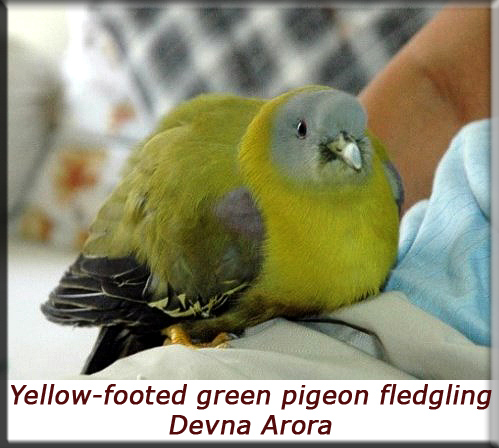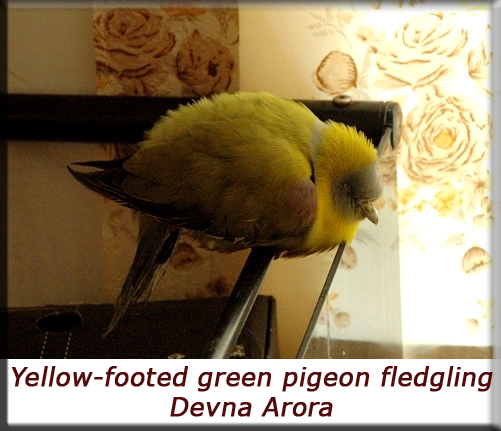Case Study: Hand-rearing a fledgling Yellow-footed green pigeon (Treron phoenicoptera)
Devna Arora
This baby was found as a fledgling (approx. 2 months of age) in Sep. 2009 in Pune, Maharashtra. He (unsexed) was kept in a closed box by his rescuers with his wings pinned so he wouldn’t fly. He was surrendered after two days when they repeatedly failed to encourage him to feed except when forcefully feeding him. The bird came with a lot of stress due to rough handling.
There was no other physical problem and although I scanned the entire area (on the 5th day that is when I could gather sufficient information) where he was found in the hope of reuniting him with his family, there was absolute no visible movement of green pigeons there. Green pigeons migrate locally in Maharashtra in search of fruiting trees and they had perhaps already moved. The fledgling was found in the city where movement of the species is infrequent, perhaps en route their journey to better feeding grounds, and was found fallen on the ground being harassed by crows.
Housing
He was rehabilitated from an indoor room of about 250 sq. feet which allowed him adequate flight practice. He was initially kept in a confined space with low perches while he would barely lift a few feet into the air. He was initially returned to a basket at night but preferred to sleep on the perch at night in two weeks’ time once he was more comfortable and confident. He started lifting higher by the third week – higher perches were put up in the room for him at that time.
He was housed next to a rock pigeon for the first couple of weeks assuming that the sight of other similar birds would calm him but every time he approached that pigeon, she aggressively chased him and he rarely ventured near her for another two weeks until he was stronger and bolder.
Diet and feeding
Due to the high stress from bad handling, he took 3 days to settle down and begin readily accepting food and had lost a considerable amount of weight in the meanwhile. Although he seemed to have eaten a small amount on the first day, he refused to eat anything for the next two days which made me resort to hand-feeding him on the 4th day. Fortunately, he didn’t require excessive fiddling or force-feeding. He just needed to get started with the first few pieces of fruit which were placed in his mouth and he soon started opening his beak to be fed. Pieces of fruit were typically offered to him by hand and his beak cleaned after his feed.
He was hand-fed 4 times a day at this point and there was always some fruit in a plate for him to eat in case he chose to pick up a few pieces on his own. Diet at this time was roughly 15-20 pieces of fruit (about 2 tablespoons) per feed. A bowl of drinking water was available to him at all times.
Diet when hand-feeding: Pieces of banana, chiku (sapodilla), papaya, figs (both cultivated and the ones plucked from trees), pears, apple, sprouted mung beans and some ground soaked almonds, equivalent to the quantity of two almonds a day.
In two weeks’ time, he started feeding on his own. At first he would pick up a few pieces of fruit from the plate and then wait to be hand-fed but thereafter began feeding independently in two days. At this point, he also became selective about his diet. His absolute favourite was chiku and it had to be perfectly ripe and sweet – there were times when I have been all around the city just to hunt for a few juicy chikus!! He would also consume ripe bananas but only once the chikus were over (and the season ended) and occasionally some shredded apple. Other seasonal fruits were offered but they were all rejected by him.
Daily diet at this point was equivalent to 2 medium-sized chikus and an equivalent amount of banana. He would feed from sunrise to about 10 pm at night. Fresh food was available for him through the day (offered 3-4 times as cut fruit goes off quickly) and he would typically consume a bit of fruit 6-7 times in a day. Probiotic supplements – Bifilac was added when required. After my experience with other birds, I would now recommend Gutwell – I have used it effectively with other birds or better still and if available, avian probiotics.
Droppings
I’m sorry I don’t have pics but dropping were much like those of any frugivorous baby bird – looped rings with very little white in them.
Growth and activity pattern
He was fairly inactive and would mostly just sit fluffed up all through the day for the first couple of weeks but became more energetic, stronger and muscular over the first few weeks itself. His colours deepened and the contrast in the plumage increased by the end of Oct. He was very active, feeding well on his own and had also started vocalizing at the same time. He was most active early in the mornings and would jump from perch to perch to exercise his wings – this was typically when he also vocalized with glee.
Observations and special considerations
Green pigeons are extremely sensitive birds. Although they are very easy to maintain, handling must be extremely gentle. More so than any other birds under rehab, exposure to unfamiliar humans is very stressful for them and MUST be avoided at all costs. It happened twice that my maid entered the room in my absence and he got a fright, stayed high up on the perch and refused to eat all day. Changing caretakers again must be avoided or they must be gradually introduced to them.
A worrying behavior was observed in him towards the end of Dec. when he would jump off his perch in the middle of the night, typically around 2-3 am and aim straight for the window. He would of course fall to the ground and flutter desperately out of fright. Unable to see in the darkness, he would not be able to lift again until I turned on the lights, after which he would return to his perch. A simultaneous dip in his appetite was observed at the same time. But as the days went by, the level of panic appeared to be less and there was more maturity and patience when he fell. This behavior continued well into the beginning of Jan and then he stopped jumping off his perch. His appetite too then returned. Perhaps this was an innate response to some migration instinct! Release was planned once he had stopped jumping off his perch at night as he likely wouldn’t have survived that behavior in the wild.
Release
He was released towards the end of Jan. 2010, at about the age of six months, in the Western Ghats where green pigeon movement is frequent. Although he survived very well and was seen 2 months after release [seen alone at the site of release and recognized by his behavior; he also acknowledged my call], he was still seen alone – return migration of the species had only just begun. Perhaps more effort to integrate him with a wild flock of green pigeons would have benefited him better but this would have meant holding on to him for another couple of months.
Case Study published in 2014.


